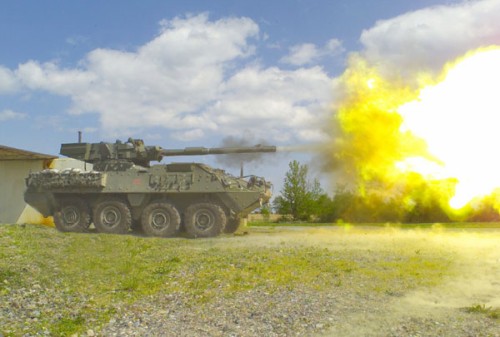|
Stryker ramps up to unveil Mobile Gun System
By Annette Fournier
May 9, 2006
FORT BENNING, Ga. (Army News Service, May 9, 2006) – The newest version of the Stryker vehicle, designed to provide fire power to Infantry units, will be unveiled May 15 at Fort Knox's Armor Warfighting Symposium.
The development of the Mobile Gun System is being managed by Fort Benning's Training and Doctrine Command System Manager-Stryker/Bradley.
The system was developed to meet the infantry’s need for a highly mobile support vehicle to supply rapid, direct fire, specifically during close assaults, said Dave Rogers, a TSM-Stryker senior analyst. The Mobile Gun System will eventually be integrated into Stryker Brigade Combat Teams.
"The Mobile Gun System brings a tremendous battlefield capability to the Stryker formation, providing direct fire support to infantrymen in close, complex terrain," said Col. Donald Sando, the director of the TSM Stryker/Bradley.
The Mobile Gun System's firepower includes a turret-mounted 105 mm cannon, a mounted M-240C machine gun and a pedestal-mounted M-2.50 caliber machine gun for the vehicle commander.
The cannon can blast holes through reinforced concrete walls creating a breach point for infantry, and destroy bunkers and machine-gun nests that typically pin down infantry squads and platoons.
The 105 mm cannon can also take out snipers, Rogers said, because with one shot, it can destroy the entire area where a sniper is firing from. The cannon also fires canister rounds, which are used when confronting large groups of combatants. The canister round sends out a spray of titanium balls, similar to the pellets from a shotgun, which can impact several targets at once.
It's the heavy fire power and versatility that will make the Mobile Gun System an asset in combat, Rogers said.
"People will assume it's a tank when they see it because it has a big gun," Rogers said, "but it's much lighter than a 70 ton tank, making it more mobile. Its primary role is to support the infantry, not to go head to head with tanks."
The Mobile Gun System also features the Ammunition Handling System, an ammo loading device for the 105 mm cannon. With the ammo system, several types of rounds can be loaded in advance, then the ammunition types are displayed on the cannon operator's central control panel monitor. Depending on the mission, the operator can select which ammunition to use and the Ammunition Handling System automatically loads the cannon.
This capability gives the Mobile Gun System an advantage over other Army vehicles, which must be manually loaded with specific ammunition by a fourth crew member, Rogers said. The Ammunition Handling System makes loading and firing on targets faster and more efficient, he said.
"When planning for the 10 variants of Strykers, the Army took into account everything a Soldier could need on the battlefield," Rogers said. "From that, they developed the other Stryker variants, like the Medical Evacuation Vehicle, the Antitank Guided Missile Vehicle and the Engineer Squad vehicles, which are all uniquely designed for their mission. The Mobile Gun System fills a hole, and gives the infantry another capability."
The Mobile Gun System will be the last Stryker variant to be fielded. The Nuclear, Biological and Chemical Reconnaissance Vehicle, the other new Stryker vehicle, was fielded to the 2nd Cavalry Regiment at Fort Lewis, Wash., in February. Soldiers with the 2nd Cav. Regt. will also be the first to receive the Mobile Gun System. They will receive 27 vehicles from July to August, which will be tested in an operational unit environment.
The Army designated 14 Mobile Gun System vehicles for extensive testing at Aberdeen Proving Grounds, Md., Yuma Proving Grounds, Ariz., and White Sands Missile Range in New Mexico.
Testing the vehicle in extreme climates and terrain helps the Mobile Gun System's designers look for potential problems that may appear in a combat environment.
"People go to great pains to almost abuse the vehicle," Rogers said. "It's tested realistically in harsh settings so we can identify any shortcomings during the testing stage. We don't want to find out about a problem after it’s in combat, so we're not cutting corners. During the tests, these vehicles aren't treated with kid gloves. We want to make sure we don't equip our Soldiers with a weak vehicle."
It will still be a while before the Mobile Gun System will get to the battlefield. The Defense Acquisition Executive will decide if the vehicle should go into full rate production in July 2007.
(Editor's note: Annette Fournier writes for the Bayonet.) |
















